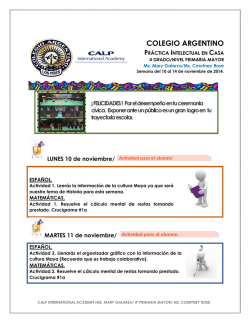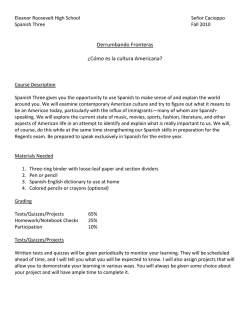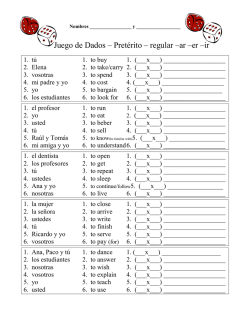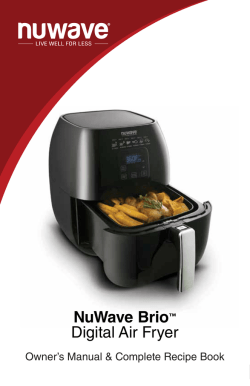
Review
sp04_te_7a_370_371.qxd 8/11/03 5:17 PM Review Review Activities Suggestions: To name foods and items in the kitchen: Have students create word searches or crossword puzzles with the new vocabulary, then pass their puzzle to a partner to complete. To follow a recipe: Have students play “What’s My Recipe?” One group will tell what ingredients are needed and the steps to be followed. The other group has to guess what dish is being prepared. Students can use simple recipes for dips or sandwiches, or recipes they have shared over the course of the chapter. To use negative tú commands and talk about food preparation: Have students prepare a list of dos and don’ts for safe and delicious cooking. Have students use irregular commands as well as other vocabulary from the chapter. Portfolio Invite students to review the activities they completed in this chapter, including written reports, posters or other visuals, tapes of oral presentations, or other projects. Have them select one or two items that they feel best demonstrate their achievements in Spanish to include in their portfolios. Have them include this with the Chapter Checklist and Self-Assessment Worksheet. Additional Resources Audio Program: CD 14, Cap. 7A, Track 13 • Resource Book: Cap. 7A, Clip Art • Resource Book: Cap. 7A, Situation Cards • Assessment Program: Chapter Checklist and Self-Assessment Worksheet Page 370 R Chapter Review To prepare for the test, check to see if you . . . • know the new vocabulary and grammar Vocabulario y gramática • can perform the tasks on p. 371 to name foods and items in the kitchen cooking oil el aceite garlic el ajo broth el caldo shrimp el camarón, pl. los camarones stove la estufa sink el fregadero fire, heat el fuego oven el horno shellfish los mariscos microwave el microondas, pl. los microondas pot la olla piece, slice el pedazo refrigerator el refrigerador salsa, sauce la salsa frying pan la sartén, pl. las sartenes vinegar el vinagre another useful expression se puede you can to follow a recipe to add añadir don’t add no añadas to beat batir to heat calentar (e ➞ ie) tablespoon(ful) la cucharada to fry freír (e ➞ í) hervir (e ➞ ie) (e ➞ i) to boil ingredient el ingrediente to mix mezclar to peel pelar to chop picar to taste, to try probar (o ➞ ue) recipe la receta negative tú commands Don’t speak. No hables. Don’t eat. No comas. Don’t write. No escribas. irregular negative tú commands no des dar no estés estar no vayas ir no seas ser Más práctica For Vocabulario adicional, see pp. 498–499. • • Realidades para hispanohablantes: Repaso del capítulo, 7A to talk about food preparation baked al horno to turn off apagar hot caliente How do you make . . . ? ¿Cómo se hace . . . ? What do you serve ¿Con qué se sirve? it with? frozen congelado, -a to leave, to let dejar don’t leave, don’t let no dejes to turn on, to light encender (e ➞ ie) canned enlatado, -a fresh fresco, -a fried frito, -a to forget about / to olvidarse de don’t forget about / to no te olvides de to spill, to throw away tirar don’t spill, don’t no tires throw away Practice Workbook Puzzle 7A-8 Practice Workbook Organizer 7A-9 370 trescientos setenta Tema 7 • Buen provecho Universal Access 370 Multiple Intelligences Students with Learning Difficulties Bodily / Kinesthetic: Write several themerelated scenarios on index cards (for example, eating in a restaurant or preparing baked fish). As a group, students pantomime the scene and the class guesses what is on the card. Play a game to reinforce the chapter’s vocabulary and grammar. Have students write five positive and five negative commands, incorporating as many vocabulary words as possible. The students receive one point per vocabulary word used. sp04_te_7a_370_371.qxd 8/11/03 5:17 PM Page 371 Review For: Test preparation Visit: www.phschool.com Web Code: jdd-0707 Preparación para el examen On the exam you will be asked to . . . Here are practice tasks similar to those you will find on the exam . . . If you need review . . . 1 Escuchar Listen to and understand someone giving instructions for cooking a meal Listen as Gabriel’s sister Valeria gives him cooking instructions over the phone. See if you can identify: (a) what he wants to cook; (b) what ingredients he still needs to buy; and (c) the first few steps in the recipe. pp. 348–351 A primera 2 Hablar Tell someone the first steps in making a particular recipe Based on the illustrations below, tell someone the first three steps in preparing paella. pp. 350–351 Videohistoria p. 355 Actividad 11 p. 358 Actividad 15 p. 367 Presentación oral 3 Leer Read and understand as someone gives general advice on cooking You are reading an article about cooking in a Spanish magazine. Tell which of the following suggestions are focused on: (a) things to do before cooking; (b) things to do while cooking; and (c) things to do after cooking. 1. Apaga el horno cuando terminas de cocinar. 2. Lee primero la receta para saber si tienes todos los ingredientes. 3. No salgas nunca de la cocina mientras algo está hirviendo. pp. 350–351 Videohistoria p. 353 Actividad 6 p. 354 Actividad 10 p. 357 Actividad 13 pp. 364–365 Lectura 4 Escribir Write rules to promote safety in the kitchen The home economics teacher asks you to write down a list of five rules for cooking safely for her Spanish-speaking students. You might begin with something like: Ten cuidado cuando picas las verduras. p. 356 Actividad 12 p. 357 Actividad 13 p. 359 Actividad 16 5 Pensar Demonstrate an understanding of how certain foods from one culture are incorporated into another culture You would like to prepare dinner for your p. 366 La cultura en vivo family using some recipes from a Mexican cookbook, but your little brother and sister are very picky eaters. What could you tell them about food(s) from another country that they have eaten before and liked? What might be the best American food or dish to introduce to teenagers from other countries? Why? trescientos setenta y uno 371 Capítulo 7A vista p. 354 Actividades 9–10 p. 358 Actividad 15 As a culminating activity, tape a few Spanishlanguage cooking shows and let students watch and write down familiar words. Have students look in Spanish-language cooking magazines and cookbooks to find familiar foods and ingredients. How are they different from what students are used to? Students could also make a collage of different dishes Standards: 1.2, 1.3, 2.1, 2.2, 4.2 Resources: Audio Program: CD 14, Cap. 7A, Track 14; Resource Book: Cap. 7A, Audio Script; Practice Answers on Transparencies 1. Escuchar Suggestions: Allow students to listen several times before they answer. Suggest they use a chart with the following heads: ¿Qué hace?, Ingredientes, Los pasos. Script: VALERIA: [answers the ringing phone] Diga. GABRIEL: Valeria, soy yo, Gabriel. Tengo una cebolla, un ajo, unos tomates y unos mariscos. ¿Es bastante para hacer una paella? ¿Cómo se hace? VALERIA: Necesitas comprar un pollo y unas verduras, como guisantes. GABRIEL: ¿Qué hago primero? VALERIA: Primero pica la cebolla y el ajo. Luego corta los tomates en pedazos. GABRIEL: Un momento. Necesito un lápiz para escribir. Answers: a. paella; b. pollo y verduras (guisantes); c. Primero pica la cebolla y el ajo. Luego corta los tomates en pedazos. 2. Hablar Suggestions: Remind students to use commands to describe the steps. Answers: Enriching Your Teaching Teacher-to-Teacher Performance Tasks from Spain, Central America, South America, and the Caribbean. a. Pica la cebolla (el ajo). b. Hierve los camarones. c. Calienta el aceite en una sartén grande. 3. Leer Suggestions: Have students read the tips first and look for words that will provide clues (terminas, primero, mientras). Answers: a. Lee primero la receta para saber si tienes todos los ingredientes. b. No salgas nunca de la cocina mientras algo está hirviendo. c. Apaga el horno cuando terminas de cocinar. 4. Escribir Suggestions: Encourage students to use both affirmative and negative commands for their rules. Answers will vary. 5. Pensar Suggestions: Have students look back at p. 366. Brainstorm a list of Mexican foods students have eaten. Point out that some children do not like spicy foods, so you could make the recipe using less chile. Answers will vary. Alternative Assessment • ExamView Test Bank CD-ROM • MindPoint Quiz Show CD-ROM • Resource Book: Cap. 7A, Situation Cards • Resource Book: Cap. 7A, Communicative Activities • Alternate Assessment: Examen del capítulo, 7A Assessment • • Examen del capítulo: 7A Audio Program: CD 21, Cap. 7A, Track 5 • Realidades para hispanohablantes: Examen del capítulo, 7A 371
© Copyright 2025





